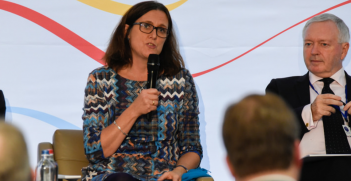The Abandonment of Procurement-linked Strategic Activism in Australia

Historically, Australia and South Korea have been staunch supporters and defenders of the multilateral trade regime. But in the early 2000s, their commitment to multilateralism began to change as they simultaneously and enthusiastically embarked upon the pursuit of preferential trade agreements (PTAs).
Strategic public purchasing: how much policy room remains under PTAs?
Following their enmeshment in PTAs, the Australian and Korean governments now find themselves facing similar external constraints on their abilities to use public purchasing for industry promotion purposes.
Australia’s most comprehensive international obligations in the public purchasing arena were made under Chapter 15 of the 2004 Australia-US Trade Agreement (AUSFTA), dedicated to Government Procurement. Chapter 15 stipulates national treatment and non-discrimination for foreign firms, placing serious constraints on the government’s ability to use its full purchasing power to nurture local firms. Yet significantly, the AUSFTA also left substantial room for policymakers to move.
The most significant scope for strategic activism comes under Chapter 15’s exemptions for policies designed to support local small and medium sized enterprises (SMEs). This exemption allowed the US to maintain its longstanding program of set-asides for SMEs, under which a portion of all government contracts are automatically reserved for small US firms.
America’s extensive use of such set asides was one reason why Chapter 15 was controversial in Australia; few seriously believed that Australian firms – typically small in size – would be able to successfully penetrate the US market in the face of such protections. These fears were well founded. A 2009 Australian Industry Group study found that 87 percent of Australian exporters surveyed believed the AUSFTA had delivered little or no improvement in their access to US government contracts.
The AUSFTA also allows the Australian government to show preference to local SMEs. Moreover, the Commonwealth Procurement Rules (which translate AUSFTA obligations into local law) stipulate that ‘the Australian Government is committed to … sourcing at least 10 percent of procurement by value from SMEs’. SMEs constitute a major segment of the Australian economy, employing around 70 percent of the workforce. Using the AUSFTA’s scope to actively support SMEs could thus make big difference to the Australian economy.
The AUSFTA also leaves scope for the government to use procurement to promote the creation and commercialisation of new technologies, products and services by local firms. Chapter 15 excludes the procurement of research and development, leaving room to experiment with SBIR-style (Small Business Innovation Research) programs. America’s SBIR program has been extremely effective at encouraging innovation and commercialization by US small firms since its introduction in the 1980s, and has enjoyed bipartisan support in the US since that time.
Evidently, Australia’s PTAs leave it significant room to move in the strategic public purchasing sphere. The same is true for Korea, which also carved out exemptions for SME promotion policies in its PTAs with the United States and Australia.
The abandonment of strategic public purchasing in Australia
Before signing the AUSFTA in 2004, the Commonwealth government dismantled its federal offsets program to become AUSFTA compliant. Between 2004 and 2011, the Australian government made no meaningful effort to capitalize on its remaining policy room to move in the strategic public purchasing sphere.
Following the 2008 Global Financial Crisis, the Rudd and Gillard governments introduced a number of strategic public purchasing programs aimed at Australian SMEs. For example, in 2013 the Gillard government announced a trial of the Enterprise Solutions Program (ESP), modeled on the US-SBIR program. This followed Rudd’s introduction and expansion of the Australian Industry Participation Plan program.
However the Abbot government dismantled all of these strategic public purchasing programs upon its 2013 election. To justify its actions, the government pointed to Department of Finance figures indicating that the Australian government already procures over 82 percent of its goods and services from “Australian Suppliers”. However, the current definition of “Australian Supplier” is very loose – based simply on whether a supplier has an ABN and a local business address. No consideration is given as to whether the goods being supplied are actually produced (in part or whole) in Australia.
Korea’s increasingly strategic approach to public purchasing
In contrast, over the past decade Korea has adopted an increasingly strategic approach to public purchasing, taking full advantage of the room it has to move under its international obligations.
Most of Korea’s efforts centre on policies designed to encourage the public procurement of technology-intensive products produced by local SMEs. A number of government ministries were tasked with identifying a select number of products produced by Korean SMEs and considered to be technologically advanced and of use to the government. Government agencies were then given incentives to purchase these products.
The impact of such policies has been significant. Between 2005 and 2011, public procurement of SME’s new technology products more than tripled in Korea.
Explaining the differences: ideas, institutions and structures
If Australian and Korean policymakers retain similar policy room to move, why have Korean policymakers been more open to and ambitious in strategic public purchasing than their Australian counterparts?
In Korea, there is longstanding consensus amongst the policymaking elite that state action is desirable and necessary to develop the country’s techno-industrial capacity and export competitiveness. Since the early 1960s, this mindset has motivated and sustained the pursuit of strategic industrial policy by Korean policymakers.
Policymakers have been able to translate their ambition into sustained strategic activism because of the institutional context in which SME-related policy is devised and implemented. Thanks to broad-ranging Constitutional powers, the Korean President remains the nation’s most influential policymaker, and since Korea’s 1997-8 financial crisis, successive Presidents have taken a strong interest in the fortunes of Korea’s SMEs – for economic and political reasons.
Korea’s contrast with Australia at the ideational, institutional and structural levels are striking. The idea of strategic public purchasing is not foreign to Australia. Yet historically, the pattern of strategic public purchasing has been shaped more by short-term political imperatives than a coherent developmental vision. This is primarily because no consensus exists amongst the political elite about the need for strategic industrial governance, or the extent to which the state should be involved in advancing the economy.
The broader structural context of the mining boom and Australia’s stand-out performance during the GFC are also significant; in Korea, perceptions of economic insecurity following the 1997 and 2007 crises, combined with the rapid rise of China, served to galvanise the developmental ambitions and sustain the political will of the policy elite to address the nation’s industrial competitiveness challenges. Such perceptions of insecurity were dampened in Australia by windfall gains in the resources sector and the government’s effective crisis management. It was thus simple for a non-developmentally minded political leadership to swiftly shift focus from techno-industrial capacity building to “budget repair” —as occurred following the election of Prime Minister Abbott in 2013.
A comparison of Australia and Korea reveals that while trade agreements limit the possibilities for strategic activism, policymakers retain significant scope to adopt a more strategic approach to public purchasing—if they so choose. For Australian policymakers searching for inspiration, Korea may be a good place to start.
Dr Elizabeth Thurbon is a Senior Lecturer, School of Social Sciences, University of New South Wales. This article is an extract from ‘The abandonment of procurement-linked strategic activism in Australia: standing still with room to move’ published in full in the Australian Journal of International Affairs Volume 69, Issue 5, 2015.





